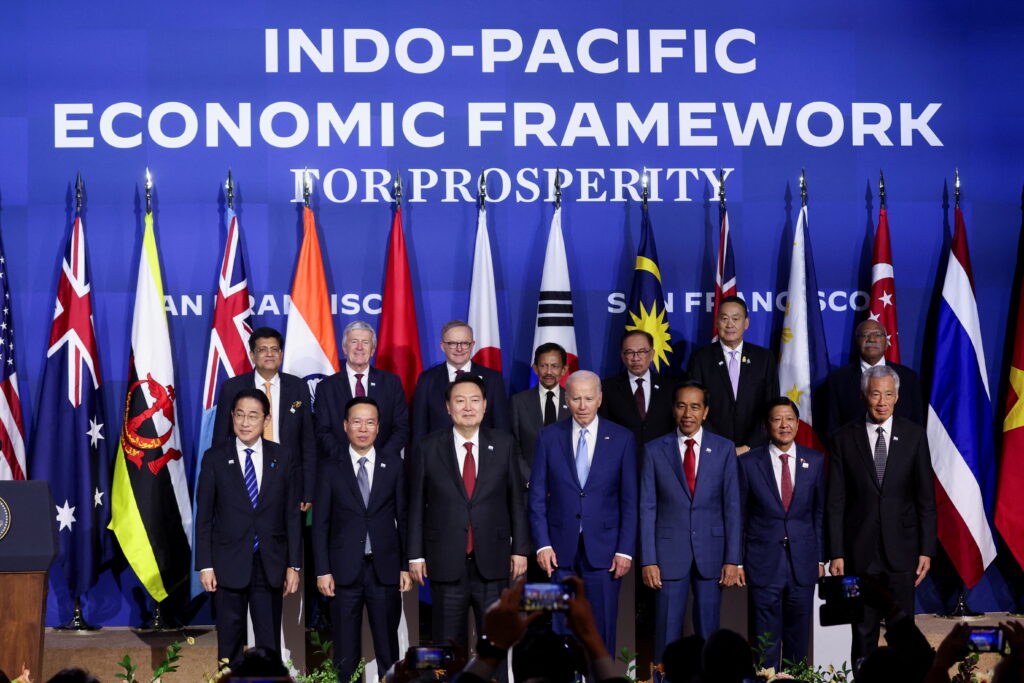As last week’s virtual IPEF ministers’ meeting in Thailand reminded everyone, negotiators for the US-led Indo-Pacific Economic Framework (IPEF) face an uphill battle to fully conclude the framework and implement key agreements before the US presidential election in November to ensure its durability.
Launched in May 2022, IPEF negotiations had proceeded relatively smoothly for three of the four pillars — the supply chains, clean economy and fair economy pillars — but right before the November 2023 Asia-Pacific Economic Cooperation (APEC) Summit, the Biden administration announced it would not conclude the trade pillar.
Biden’s fellow Democrats assumed it could turn into a disastrous campaign issue, especially in light of former US president Donald Trump’s saying he would ‘knock out’ the IPEF, calling it the Trans-Pacific Partnership (TPP) 2.0 and even worse than TPP. Trump withdrew the United States from the TPP in January 2017, effectively killing it and causing other members to pursue an alternative trade agreement, the Comprehensive and Progressive Trans-Pacific Partnership.
The same could be in store for the IPEF.
The Office of the US Trade Representative (USTR) negotiated the first pillar — known as the trade pillar despite it not including market access — but it had been clear well in advance that it would not reach ‘substantial conclusion’ by the time the APEC Summit was held. One major issue was over digital trade — members of Congress were concerned about the influence of giant tech over rules around cross-border data flows, data localisation and source code.
It was also a political issue. US Senator Sherrod Brown, running to keep his seat, issued a press release days before APEC that urged dropping the trade pillar because it would harm US workers. It is unclear how USTR will approach the trade pillar in 2024. US policymakers familiar with the issue suggest that although it was expected that it would not be concluded at APEC, there would be considerable work on the pillar this year.
IPEF members recognise that this is a US election year and are likely managing their expectations of any significant work getting done on the pillar in that context, despite rosy talk from US policymakers on the prospects of delivering more.
Privately, IPEF members have expressed concern about US engagement in IPEF and the framework’s likelihood to endure. With the precedent set by Trump’s withdrawal from TPP and the failure to complete the trade pillar, there is a feeling of deja vu. But there are milestones to be met in 2024 that could save the endeavour yet.
In 2023, IPEF members announced a supply chain agreement that was lauded as the ‘world’s first multilateral supply chain agreement’ to ‘make [their] supply chains more resilient and competitive’ and ‘establish a framework for lasting cooperation’.
This agreement went into force on 24 February 2024 and in the coming months members are expected to establish three supply chain bodies — the Supply Chain Council, a Crisis Response Network and a Labour Rights Advisory Board. By August 2024, each body should have a chair and representatives, terms of references, each member country’s list of critical sectors and goods for cooperation and guidelines for the facility-specific reporting mechanism on labour rights inconsistencies in IPEF supply chains.
The supply chain pillar, its agreement and its three bodies, are the most tangible outcomes of IPEF so far. Progress on building and bringing into being the bodies and the nodes of the agreement will determine the durability of the pillar.
The same is possible for the other pillars. The clean economy pillar can make more progress on decarbonisation and energy transitions, particularly in developing economies.
In November 2023, member countries published outlines of their ambitions, such as ‘promoting solutions’ and ‘aim to work towards…’ rather than definitive commitments to cooperation. In the same fact sheet, IPEF countries announced the creation of an IPEF Catalytic Capital Fund to pool resources and expand the pipeline of bankable climate infrastructure projects in IPEF emerging and upper-middle income economies that participate the pillar. They also launched the IPEF Clean Economy Investor Forum to catalyse investment for sustainable infrastructure and climate technology for IPEF members that are part of the Clean Economy Agreement.
Without market access, these provide incentives for joining pillars — the promise of financing and investment. But IPEF, particularly the developed country signatories, will have to set a clear agenda with actionable steps to ensure the fund and the forum deliver results. This will help lessen concerns around the viability of the IPEF and the incentives for members to engage.
IPEF did not achieve what policymakers and member countries hoped it would at APEC in 2023 and there are justified concerns that if Donald Trump is elected president of the United States, he will once again withdraw the country from an Asia-focused economic framework. If that does occur, countries in the region would think twice if the United States approaches them with yet another economic agreement.
IPEF members have signalled that substantive work will be done, primarily on the supply chain pillar. If signatories and non-members are to be expected to trust in the durability of this agreement, IPEF members will have to set a clear agenda with tangible deliverables on the other three pillars — trade, clean and fair economy — to lock the framework in before the November election.
Erin Murphy is Senior Fellow for the Asia Program at the Center for Strategic and International Studies.


The US-led Indo-Pacific Economic Framework (IPEF) remains undeveloped in key areas and faces uncertainty about its future as the 2024 US presidential election looms. The durability of the IPEF heavily relies on significant work to be done on other pillars, including trade, clean and fair economy pillars, amid concerns about future US engagement and the risk of US withdrawal should Donald Trump return to the White House.